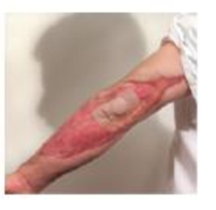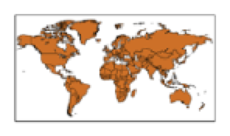
Necrotizing Fasciitis

Fever, chills, nausea, weakness, and general yuckiness. Carlos thought he was getting the flu. Further, he had pulled a cactus thorn from his arm the day before, and the tiny wound had swollen to a centimeter in diameter. It was red, extremely hot, and much more painful than such a puncture had a right to be. Everything was against him. He couldn’t afford to miss days at work, but he had no choice.
He shivered in bed with fever for the next two days and suffered more pain than he had ever experienced, certainly more than the time he broke his leg. Even more than passing a kidney stone. The red, purple, and black inflammation on his arm had grown to the size of a baseball. It was hard to the touch and excruciatingly painful. He decided it was time to call his brother to take him to the doctor. That decision saved his life.
Carlos’s blood pressure dropped severely, and he was unconscious by the time they arrived. The physician immediately admitted Carlos to the hospital, where the medical team raced to treat necrotizing fasciitis, commonly called “flesh-eating” disease. This reemerging disease is caused by group A Streptococcus, a serotype of Gram-positive bacteria also known as Streptococcus pyogenes. Group A strep invades through a break in the skin and travels along the fascia-the protective covering of muscles-producing toxins that destroy human tissues, affecting about 750 people each year in the United States.

By cutting away all the infected tissue; using high-pressure, pure oxygen to inhibit bacterial growth; and applying antimicrobial drugs to kill the bacterium, the doctors stabilized Carlos. After months of skin grafts and rehabilitation, he returned to work, grateful to be alive. (For more about necrotizing fasciitis, see pp.560-561.)
1. What color do cells of S. pyogenes appear after the
Want to see the full answer?
Check out a sample textbook solution
Chapter 4 Solutions
Microbiology with Diseases by Body System (4th Edition)
- 1. Match each vocabulary term to its best descriptor A. affinity B. efficacy C. inert D. mimic E. how drugs move through body F. how drugs bind Kd Bmax Agonist Antagonist Pharmacokinetics Pharmacodynamicsarrow_forward50 mg dose of a drug is given orally to a patient. The bioavailability of the drug is 0.2. What is the volume of distribution of the drug if the plasma concentration is 1 mg/L? Be sure to provide units.arrow_forwardDetermine Kd and Bmax from the following Scatchard plot. Make sure to include units.arrow_forward
- Choose a catecholamine neurotransmitter and describe/draw the components of the synapse important for its signaling including synthesis, packaging into vesicles, receptors, transporters/degradative enzymes. Describe 2 drugs that can act on this system.arrow_forwardThe following figure is from Caterina et al. The capsaicin receptor: a heat activated ion channel in the pain pathway. Nature, 1997. Black boxes indicate capsaicin, white circles indicate resinferatoxin. a) Which has a higher potency? b) Which is has a higher efficacy? c) What is the approximate Kd of capsaicin in uM? (you can round to the nearest power of 10)arrow_forwardWhat is the rate-limiting-step for serotonin synthesis?arrow_forward
 Medical Terminology for Health Professions, Spira...Health & NutritionISBN:9781305634350Author:Ann Ehrlich, Carol L. Schroeder, Laura Ehrlich, Katrina A. SchroederPublisher:Cengage Learning
Medical Terminology for Health Professions, Spira...Health & NutritionISBN:9781305634350Author:Ann Ehrlich, Carol L. Schroeder, Laura Ehrlich, Katrina A. SchroederPublisher:Cengage Learning- Health Safety And Nutrition F/Young ChildHealth & NutritionISBN:9781305144767Author:MAROTZPublisher:Cengage





